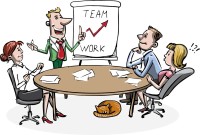- Home
- Business Processes
- Industry Knowledge
- Aerospace Industry
- Automotive Industry
- Banking Domain
- BFSI Industry
- Consumer/ FMCG Industry
- Chemicals Industry
- Engineering & Construction
- Energy Industry
- Education Domain
- Finance Domain
- Hospitality Domain
- Healthcare Industry
- Insurance Domain
- Retail Industry
- Travel and Tourism Domain
- Telecom Industry
- Leadership Skills
- eLearning
- Home
- Leadership
- Leadership Styles
- The Skill of Decision Making
The Skill of Decision Making
In its simplest sense, decision-making is the act of choosing between two or more courses of action. Decision making is a key skill in the workplace and is particularly important if you want to be an effective leader. When decisions have to be made, there are several stages that you should go through to reach a practical solution. Understand the meaning and importance of decision making and how to look at it as a process.
Decision-making is an activity that all of us involved in almost day in and day out. You will possibly agree that decision making is a part of everyday life. Similarly, making decisions by both individuals and groups is a fundamental aspect of life in organizations.
It is the most common and crucial work role of executives. The ability to make timely decisions, to exercise independent judgment, and to gain positive results is the basic nature of effective decision making. Whether you are at a board meeting or in the playground, you are almost constantly making decisions, sometimes working on several at the same time.
These may be major or minor, but some of these might have proved to be effective decisions, viz. appropriate, timely, and acceptable. Some of your decisions might have been wrong, but you knew that there was something worse than a few wrong decisions and that was indecision!
Definitions of Decision Making
- Decision making is the process of making choices from among several alternatives.
- Decision making is the process of choosing actions that are directed towards the resolution.
- Decision making is the selection from among alternatives of a course of action: it is at the core of planning.
- Decision making is a process of selection from a set of alternative courses of action which is thought to fulfill the objectives of the decision problem more satisfactorily than others.
- Decision making is an essential part of every function of management.
- In the words of Peter F. Drucker, "Whatever a manager does, he does through decision making."
- Decision making involves thinking and deciding before doing and so is inherent in every activity. That is the reason decision making is often called the "essence" of managing.
Importance of Decision Making
Making decisions has been identified as one of the primary responsibilities of any manager. Decisions may involve allocating resources, appointing people, investing capital, or introducing new products. If resources like men, money, machines, materials, time, and. space was abundant, clearly, any planning would be unnecessary. But, typically, resources are scarce and so there is a need for planning.
- Decision making is at the core of all planned activities
- The determination of objectives, policies, programs, strategies, etc. involves decision making.
- No one can survive without effective decision making
- Scarce resources may get waste or underutilized due to wrong decisions or by remaining indecisive
- Decision making is important for organizational effectiveness because of its central role in the overall process of directing and controlling the behavior of organizational members
- Decisions making also involves the setting of goals, strategic planning, organizational design, personnel actions, and individual and group actions.
- It is very important to understand the dynamics of decision making which may help to avoid urgency and emergency situations
- The quality of a decision has a bearing on one’s professional success and a sense of satisfaction
States of Decision Making
Some of the decisions may be of a routine type and repetitive in nature and some may be strategic in nature which may require a lot of systematic and scientific analysis. In some cases the decision-maker may not have complete knowledge about decision alternatives (i.e., High Problem Complexity) or about the outcome of a chosen alternative (i.e. High Outcome Uncertainty). These conditions of knowledge are often referred to as states of nature and have been labelled as:
- Decisions under Certainty
- Decisions under Risk
- Decisions under Uncertainty
The Process of Decision Making
The decision-making process can be carried out either by individuals acting alone or by groups. The quality of our decisions is often much poorer than we realize. Selective perception tends to bias the information we use in making decisions and our attitudes and values influence how we interpret that information. Many factors create bias and degrade our decisions and limit our understanding of the decision making problem,
Sometimes making a decision is facilitated by the background information and circumstances but there are occasions when one is left into blank and the manager is forced to make a decision. Such decisions may not lead to the target and may also create undesirable situations and regulations which ultimately may mar the whole process.
To overcome this problem there are several models and theories which are developed to explain decision making and how effectively you can make a decision. Though there is no magic formula for analyzing data, considering option,s and making a winning determination, there is a multistep process to arrive at decision. Using the process approach for decision making will enable us to make better quality decisions than we do presently. In order to increase our effectiveness in decision making, we must first understand the decision-making process. Following a process offers the greatest chance of resolving many problems.
- Decision making and planning are deeply interlinked.
- How do you typically assess the success of a business decision you have implemented? What will you do differently in the future?
- The decision-making process involves three stages planning the implementation, managing the implementation, and evaluating the decision.
- It reviews how to use grassroots analysis to strengthen the plan.
- It focuses on involving stakeholders, adjusting the plan once it is in process, and managing resistance.
- Finally, it looks at how to assess the quality of a decision outcome as well as address decision failures.
Related Links
You May Also Like
-
Change is a complex phenomenon. There are different types of changes that are going on around us. Listed in this article are twelve areas in which change arises and bring some classification to it. However one may classify the change, the various heading is always interrelated. The change could be triggered by market changes, technological changes, or organizational changes.
-
Process & Stages of Creativity
Creative ideas do not come just like that. There is a process to it. There are a number of techniques of creativity to support the generation of ideas but the widely practiced ones are brainstorming and lateral thinking. Most innovations are not so much the product of sudden insights as they are the result of a conscious process that often goes through multiple stages. The creative process can be divided into four stages of preparation, incubation, evaluation, and implementation.
-
Reasons behind Wastage of Time
Under-utilization of time may be due to the faulty system or faults of manager/officer/leader or due to lack of planning. There could be many factors driving the procrastination behavior like system issues, personal work habits, and lack of delegation, personality traits, and bad working habits of the leader, failure to tackle interpersonal conflicts, obstacles, and lack of far-sightedness.
-
Tips for Effective Time Management
After studying and analyzing how time is spent, why time is wasted, and where time is wasted you need to decide about the changes required for effective utilization of time. For this purpose, a large number of remedial measures can be taken by you. The first and foremost determinant of a planned and purposeful utilization of time is to develop consciousness of the value of time at all levels of the organization. Planning, goal setting, and defining priorities are concerns to addressed immediately.
-
“Level 5 Leadership”, this term was coined by Jim Collins in his book “Good to Great” and it is all about achieving "Greatness" as a leader. This article will explain what we mean by Level 5 Leadership and what the characteristics of a Level 5 leader are. What it takes to achieve greatness as a leader, and what are the steps and strategies that one can use to move up to this top level of leadership.
-
Generating Ideas using SCAMPER
SCAMPER is an activity-based thinking process that can be performed by Cooperative learning. SCAMPER is an acronym that provides a structured way of assisting students to think out of the box and enhance their knowledge. This can be used in the organizational context as a technique for creative problem solving and as a toolkit to generate fresh ideas.
-
Storming Stage of Team Development
Storming is the second stage of team development and this stage is characterized by a bid for power and inter-personal conflicts. Learn the key factors that occur in the storming stage and the strategies that a team leader can adopt to pass this stage of high winds
-
Building Perfect Creative Team
One misconception around creativity is that creative act is essentially solitary. Most of the world's important inventions resulted not from the work of one lone genius, but from collaboration of a team with complementary skills. Managers should build teams with the ideal mix of traits to form a creative group and then establish the conditions that make creativity much more likely to occur.
-
Tools for Developing Your Team
If a manager has too many weak spots in the talent of the team, the ability to empower the team members to independently execute the project is impaired. Assignments fall behind schedule or stretch out because the needed skills or knowledge are not in place when needed. To successfully execute important projects, hiring talented people, and increasing the talents of existing staff are most important.
-
All the teams are dynamic in nature and they take time to come together, they form, develop, and grow in stages, over a period of time. Teams go through five progressive stages: Forming, Storming, Norming, Performing and Adjourning. In this article, we want to introduce you to these stages of team development and certain strategies that you can use to help the team grow and develop in each of these stages.
Explore Our Free Training Articles or
Sign Up to Start With Our eLearning Courses

About Us
Learning
© 2023 TechnoFunc, All Rights Reserved










